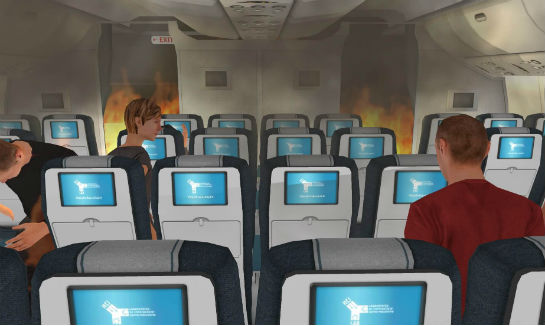Estimated reading time 6 minutes, 18 seconds.
“Prepare for Impact,” the latest in a series of smart phone apps developed by the Human-Computer Interaction (HCI) Lab at the University of Udine, Italy, is a next-generation method of teaching aviation safety. HCI Lab Photo
A flight attendant ushers you down the aisle of an airliner about half-full of passengers, whose heads peek out at you from the tops of blue-grey seats.
Later, as the airliner cruises the sky, you watch scenery rush past your window—swaths of green field dotted with patches of brown.
Then, an explosion.
The plane jostles briefly, and bright orange flames flow from the starboard wing. A tranquil, routine flight has become a potential disaster.
Do you know what to do next?
All of this occurs in a virtual space, with computer-generated images that appear on your smart phone or tablet.
But it could be part of a next-generation method of teaching aviation safety, and a way to improve troublingly low comprehension of traditional safety instructions.
These are scenes from “Prepare for Impact,” the latest in a series of smart phone apps developed by the Human-Computer Interaction (HCI) Lab at the University of Udine, Italy.
The apps guide users through video game-style levels that teach them what to do in the event of a flight emergency such as in-flight decompression, a ground collision, runway overrun, water landing or crash landing. HCI Lab Photo
“Passengers do not pay attention anymore to the safety instructions provided by airlines,” said Prof. Luca Chittaro, director of the HCI Lab, in an email interview. “Pictograms used in safety cards and the audio-visual illustration of instructions in briefings are not clear enough to comprehend or can be difficult to remember for many passengers,” he added.
“So, for airlines that want to improve passengers’ level of emergency preparedness, the problem is twofold: in addition to getting the attention of the passengers, safety instructions should also become easier to understand and remember.”
Interactive media can play a significant role in improving comprehension, he said. It can show users what to do in realistic three-dimensional worlds from multiple viewing angles and provide personalized feedback based on the errors they make.
A study revealed that 90 per cent of participants learned a brace position for emergency landings using “Learn to Brace,” another app the HCI Lab developed. Only 33 per cent of participants learned the position using safety cards. HCI Lab Photo
“The app supports an experiential, active exploration of the brace instructions, instead of the passive watching of traditional safety briefing media,” said Chittaro. “Users have to ask themselves where they would actually put their head, hands, feet during an emergency landing and then pose their 3D avatar in that way.
“Then, following a game-like format, the app shows them the effects of their choices in vivid and memorable ways. In this way, interactivity allows users to understand better the cause-effect relations between passenger’s correct or wrong actions and their consequences.”
While “Prepare for Impact” is aimed at improving in-flight safety, the developers expect people to engage with it in their spare time on the ground, not during flights. For this reason, HCI Lab is also developing an interactive version of airline safety cards that runs on wearable virtual reality headsets and tablets and could be suitable for in-flight use.
More than 150,000 users downloaded and played the app in the first two months after its release in March 2016. HCI Lab Photo
With so many things competing for a passenger’s attention, it may be difficult to entice them to play a safety-related smart phone game in their spare time.
But the fact that “Prepare for Impact” is designed as a game motivates people to use it, said Chittaro. He noted more than 150,000 users downloaded and played the app in the first two months after its release in March 2016.
“Many of these users have played ‘Prepare for Impact’ for several hours, reaching impressive performance in the game leaderboards,” he said. “One thing that airlines will have to do, sooner or later, is to make the on board safety briefings interactive, to make them more engaging as well as more easy to understand and remember for passengers. “Our research project is exploring the different aspects of interactivity that are useful to reach such goals.”
“Prepare for Impact” and other HCI Lab apps are available as free downloads from Google Play and the Apple App Store.







